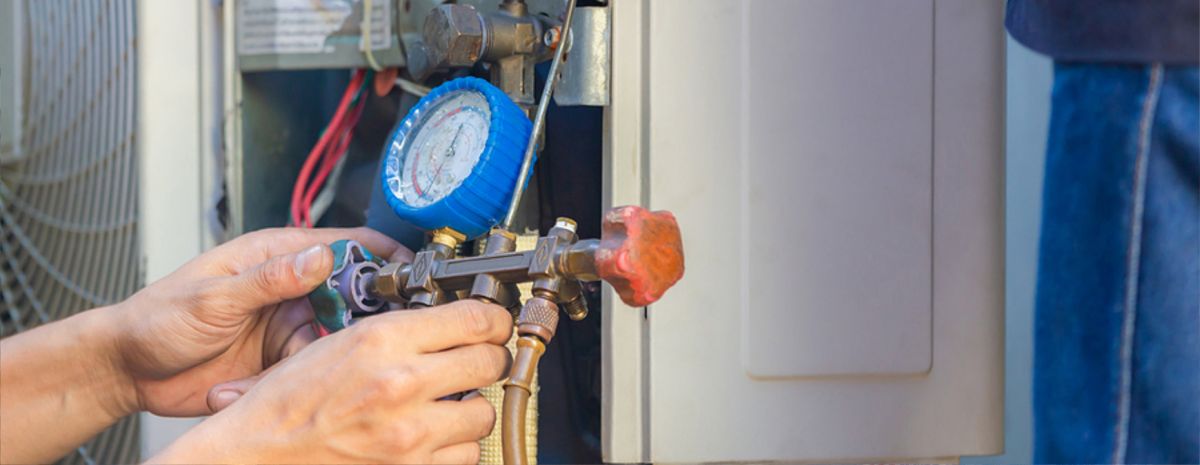
Manifold gauges can be one of the most essential tools for HVAC technicians and are likely one of the first instruments you’ll learn about in your HVAC classes.1
These important tools are used to check the pressure of gases and liquids in a heating or cooling system.2
See how they work in this article.
What Is a Manifold Gauge?
A manifold gauge is a pressure-checking system. They are one of the most basic HVAC tools, and can be used as both a diagnostic and service tool.2,3
In diagnostics, a manifold gauge tells an HVAC technician if the system is operating correctly, or if there is a problem within the system that needs to be addressed.4
Get Started on the Path to a New Career
Fill out our form to learn how we can help you change your life.
When used as a service tool, a manifold gauge can be used to release moisture and sludge, and remove contaminated refrigerants from the system.2,4
Manifold Gauge Parts
While manifold gauges will differ slightly among manufacturers, most manifold gauges have the same basic parts, consisting of a high-pressure valve (red) and a low-pressure valve (blue). Attached to these valves are three hoses: a blue hose connected to the low pressure valve, a red hose connected to the high pressure valve and a yellow hose in the middle, which can be directed to either valve.3
The center unit where everything is attached together is called the manifold, which is why this tool is called a manifold gauge.3
The basic parts of a standard manifold gauge include:4
- Low-pressure valve
- High-pressure valve
- Low-pressure gauge (blue)
- High Pressure Gauge (red)
- Low-pressure hose (blue)
- High-pressure hose (red)
- Center hose (yellow)4
- Center piece/manifold3
Manifold gauge sets can be either analog or digital, and some may have additional valves or functions, depending on the brand, inclusions and other considerations.1
What Is a Manifold Gauge Set Used For?
Manifold gauges are used to monitor heating or cooling systems, specifically the pressure of refrigerants. These tools are used to control the flow of pressure or gas.5
HVAC gauges can either be small handheld devices, or bigger machines used in a professional HVAC shop.6
Manifold gauge sets can be used in the following ways:
- Checking pressure in AC lines
- Determining if there’s a leak
- Adding small amounts of refrigerants
- Refrigerant evacuation
- Recharging6
- Troubleshooting3
- Repairing AC and HVAC systems2
Most gauges can be used to measure any refrigerant pressure, but each gauge may vary in function and specifics. A manifold gauge must match the refrigerant used in the HVAC system. Every heating or cooling system will have a stamp showing what refrigerant is used. Some gauge sets can read multiple refrigerants. You will want to make sure you are using the right gauge for the right refrigerant reading.3
How Do Manifold Gauges Work?
A manifold gauge works by sending a flow of gas through the set. The yellow hose can be connected to an external source, such as a vacuum pump or refrigerant bottle. Depending on the situation, the low-pressure blue valve and high-pressure red valve would be connected appropriately.3
Here are a few examples of how manifold gauges work:
- Pressure Readings: When taking pressure readings, the red hose would be connected to an HVAC high-pressure line and the blue hose would be connected to an HVAC low-pressure line. Then the HVAC technician would simply look at the gauges and record the reading.3
- Vacuuming: In the case of vacuuming, the yellow hose would be attached to a vacuum pump, and the blue hose would go to the unit. The blue valve would be left open so the pump could work.3
- Adding Refrigerant: If refrigerant is being added to an AC unit, the yellow hose would connect to the external source, the refrigerant bottle, and the red hose would be connected to the unit. The HVAC technician would monitor how much refrigerant is being added to the system and turn it off when it reaches the correct amount.3
Calibrating Your HVAC Manifold Gauge
An HVAC manifold gauge can help you check the pressure of the lines of an HVAC system, as well as troubleshoot problems.2,3
But, similar to the equipment they check, manifold gauges also need to be serviced from time to time.
This means HVAC/R tool calibration can be another important skill for an HVAC technician to learn.
Additional Sources
1https://www.zoro.com/manifold-gauge-sets/c/6282/
2https://megadepot.com/resource/why-and-how-to-use-hvac-gauge-manifolds
3https://www.hvachowto.com/how-hvac-gauges-work-tutorial-for-beginners/
4https://automationforum.co/manifold-gauges-air-conditioning-gauges/
5https://www.tequipment.net/hvac-equipment-and-instruments/hvac-manifolds-and-gauges/
6https://www.carid.com/articles/how-to-use-an-air-conditioning-manifold-gauge-set.html
This blog has been labeled as archived as it may no longer contain the most up-to-date data. For a list of all current blog posts, please visit our blog homepage at https://www.rsi.edu/blog/

